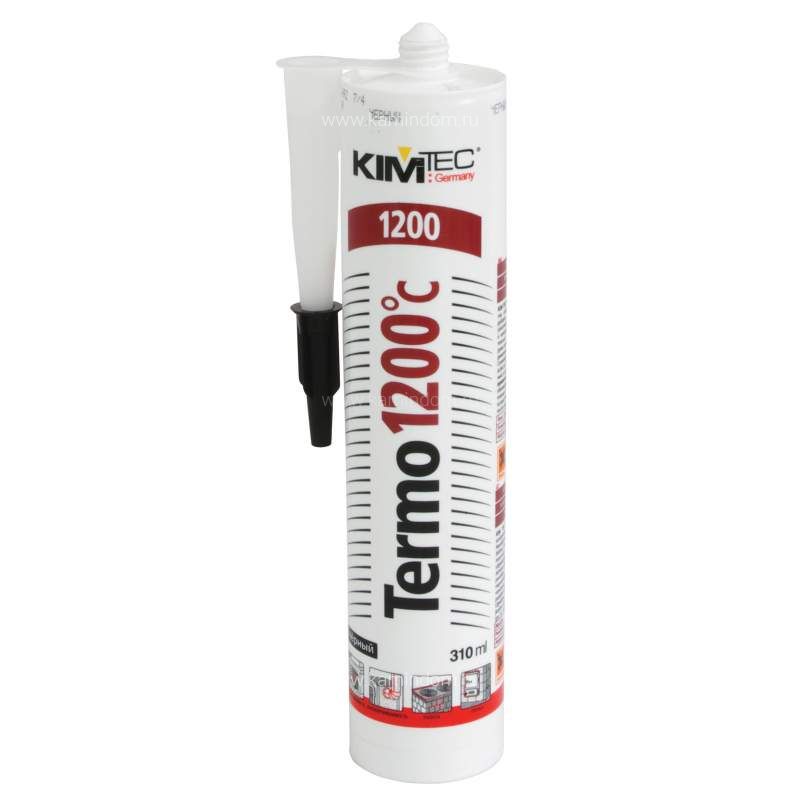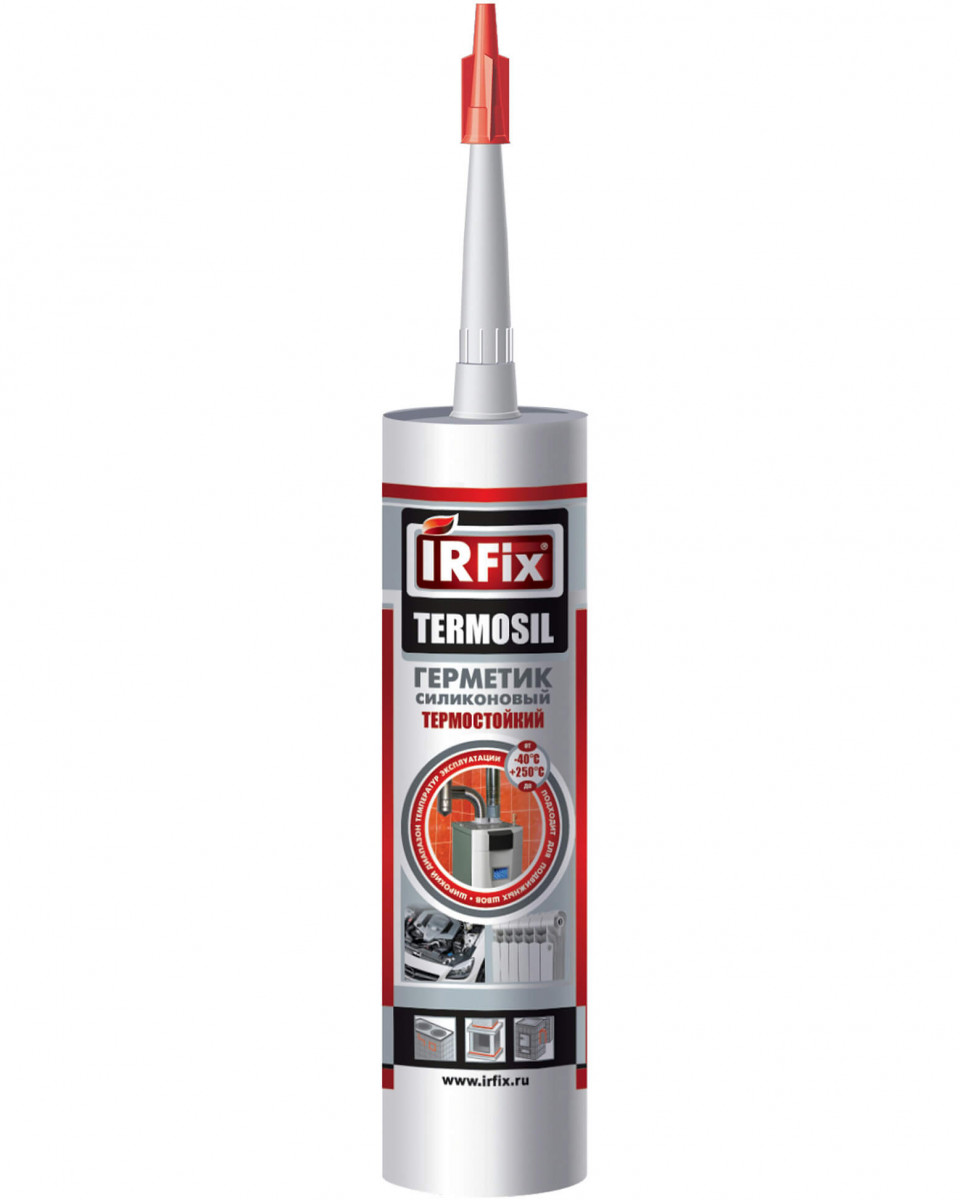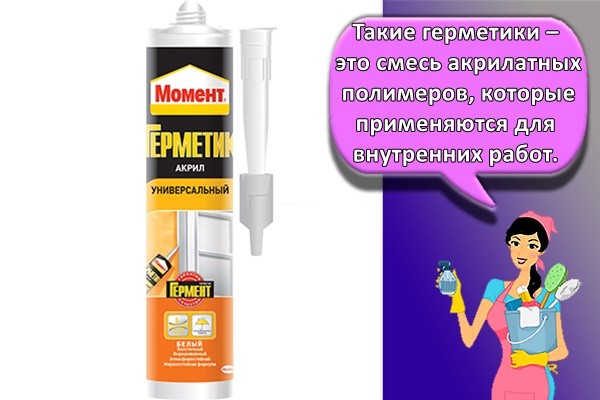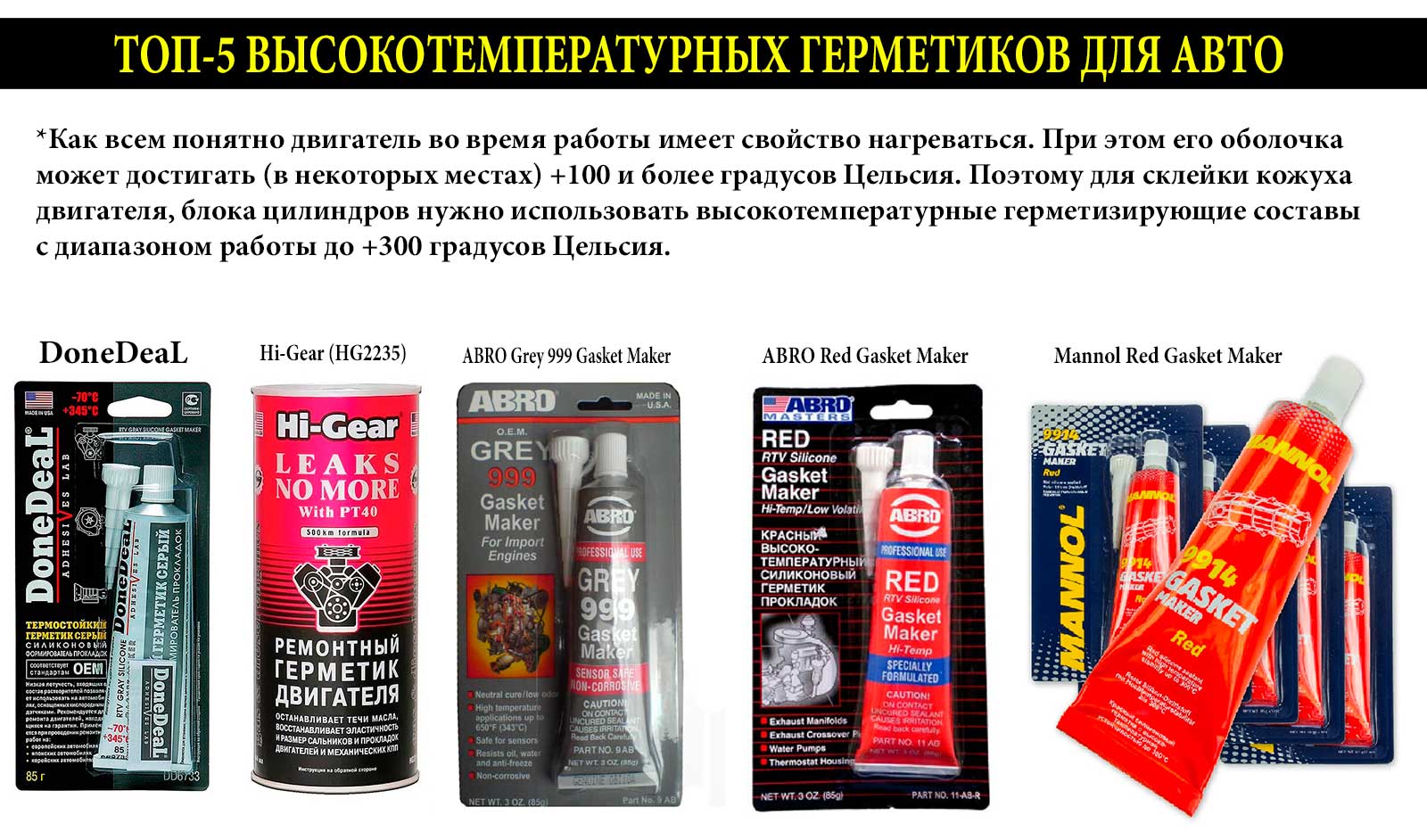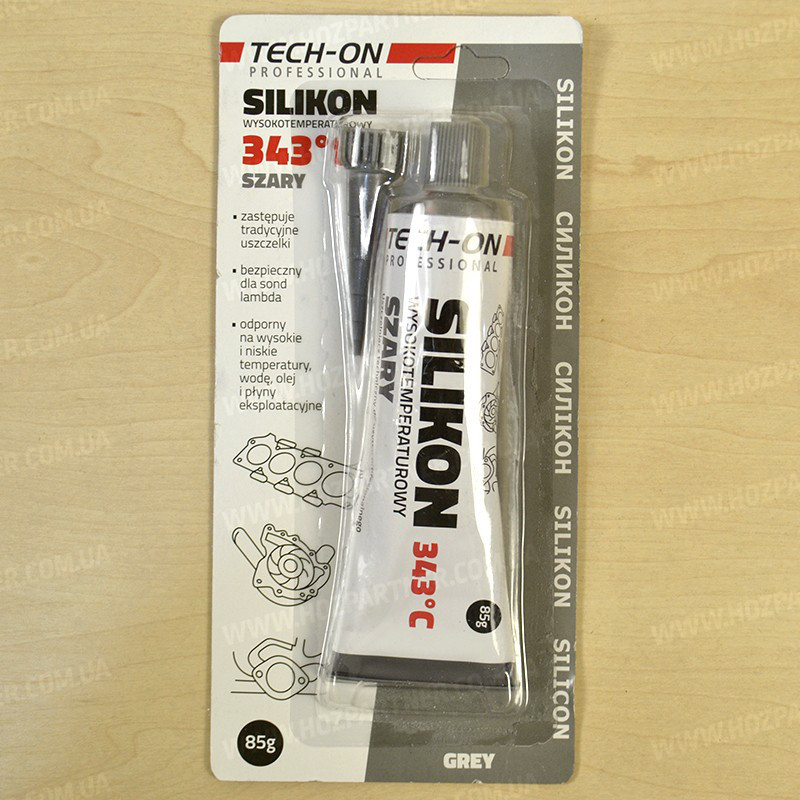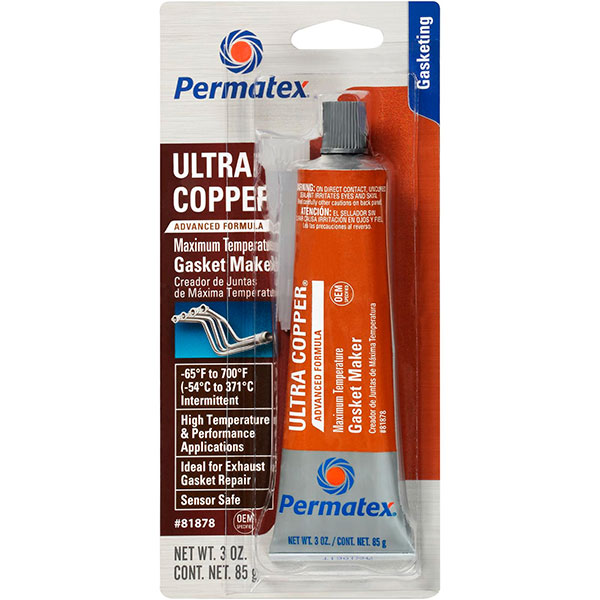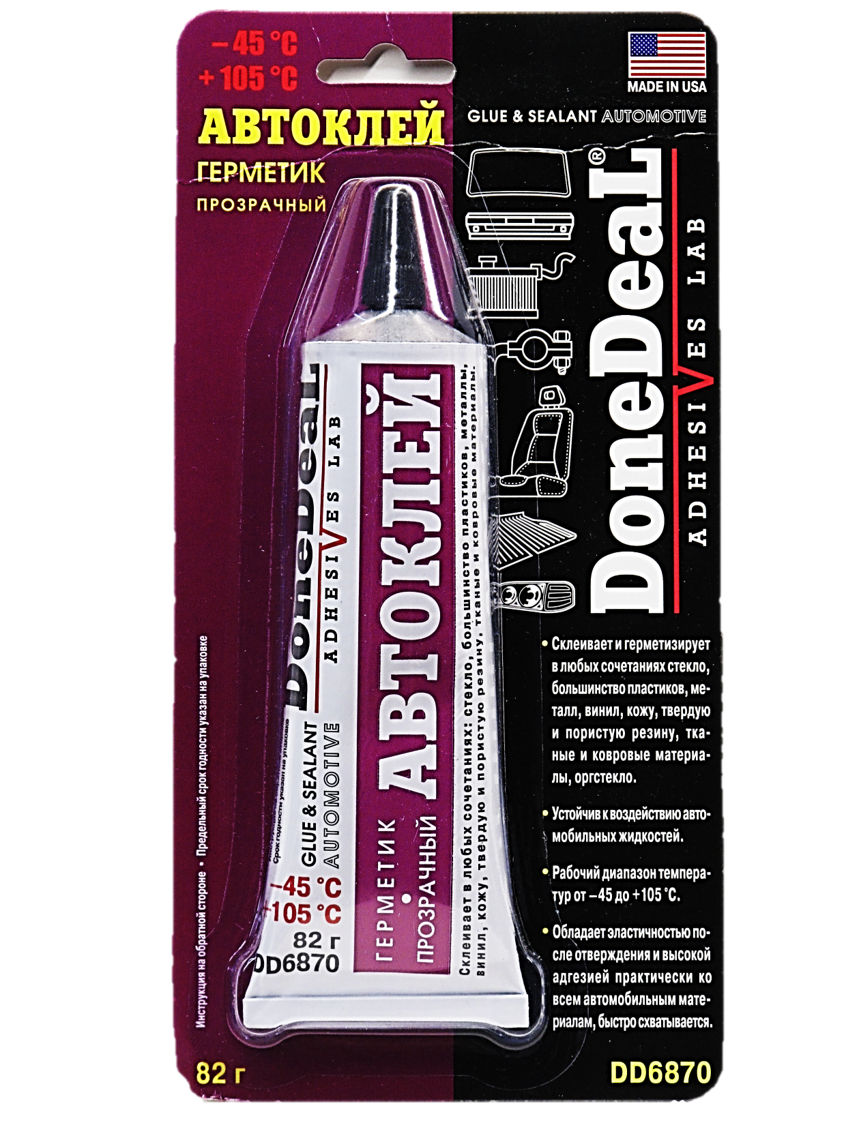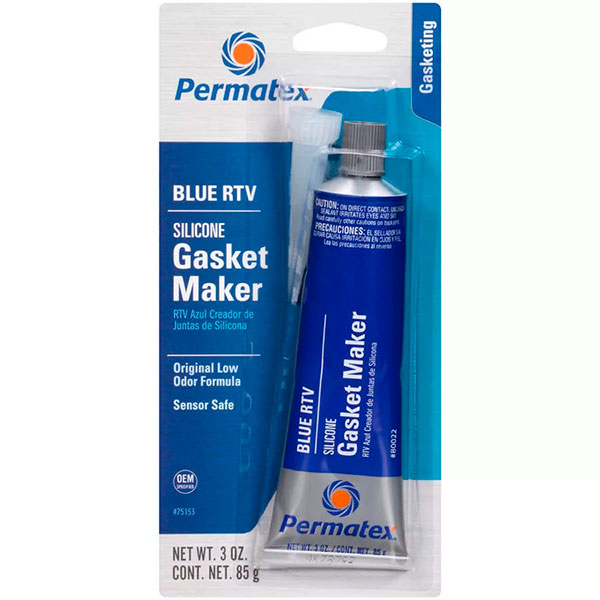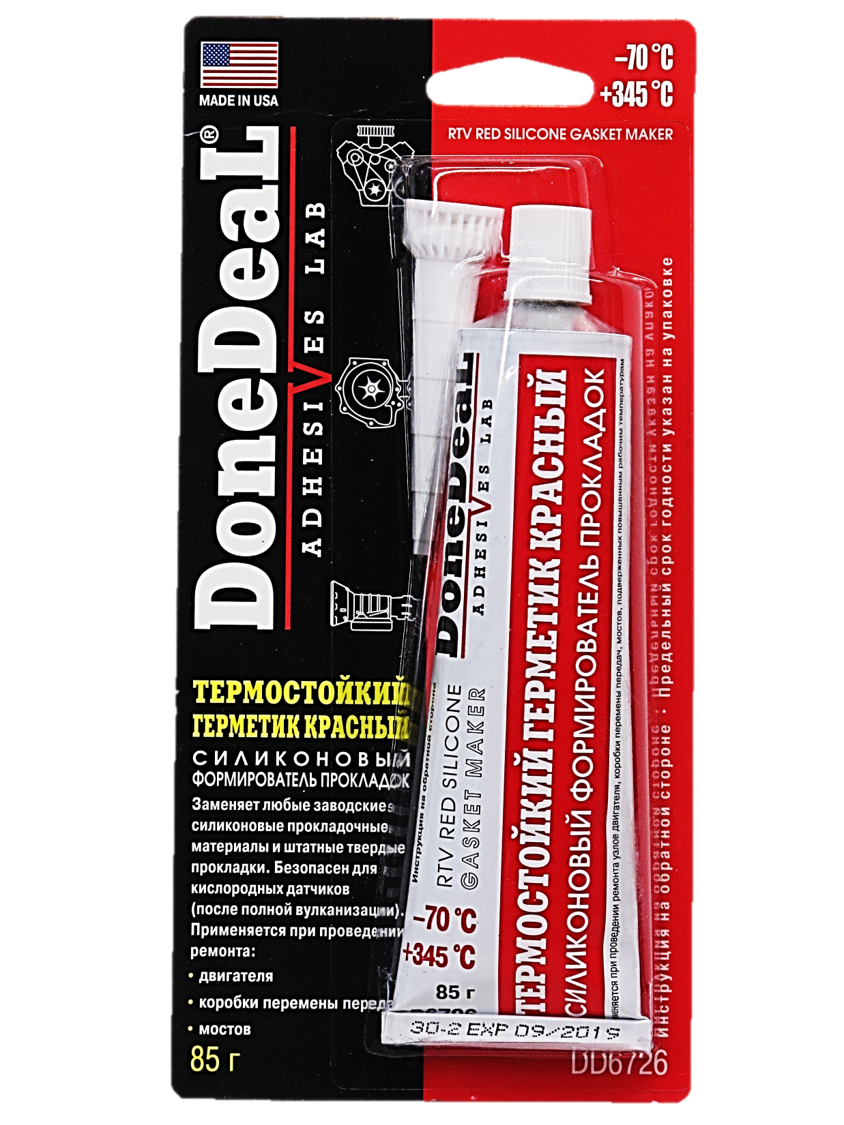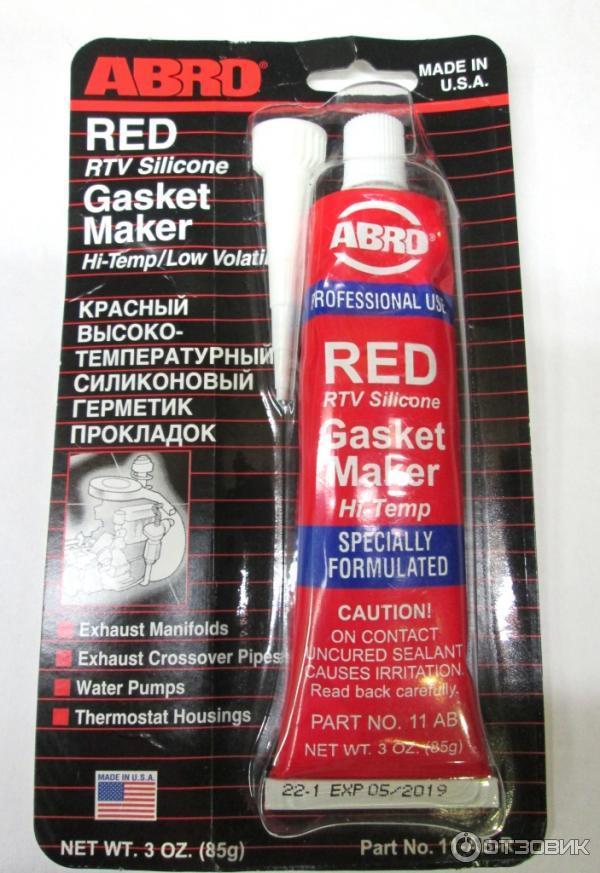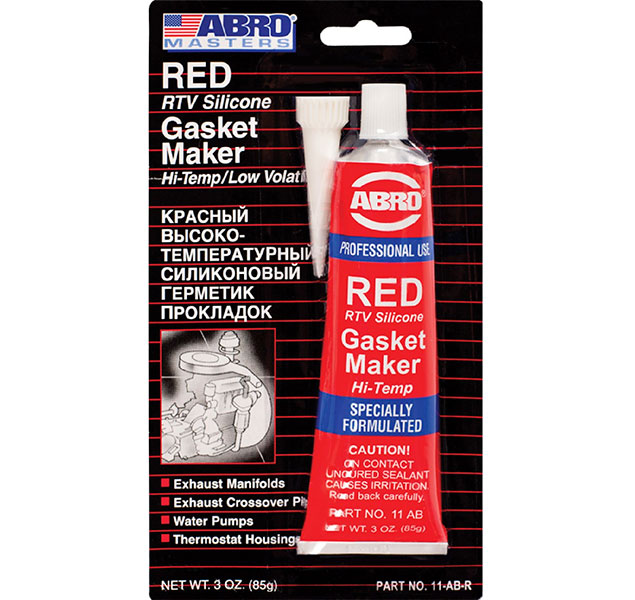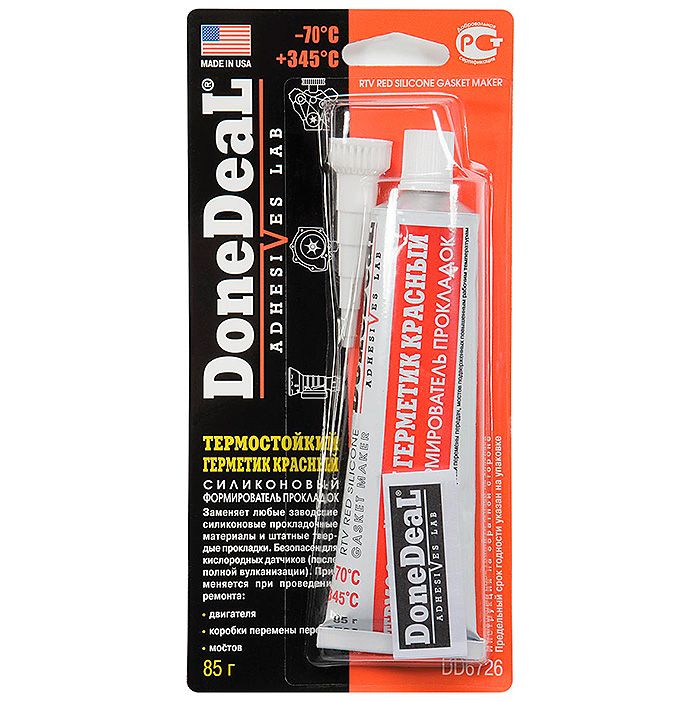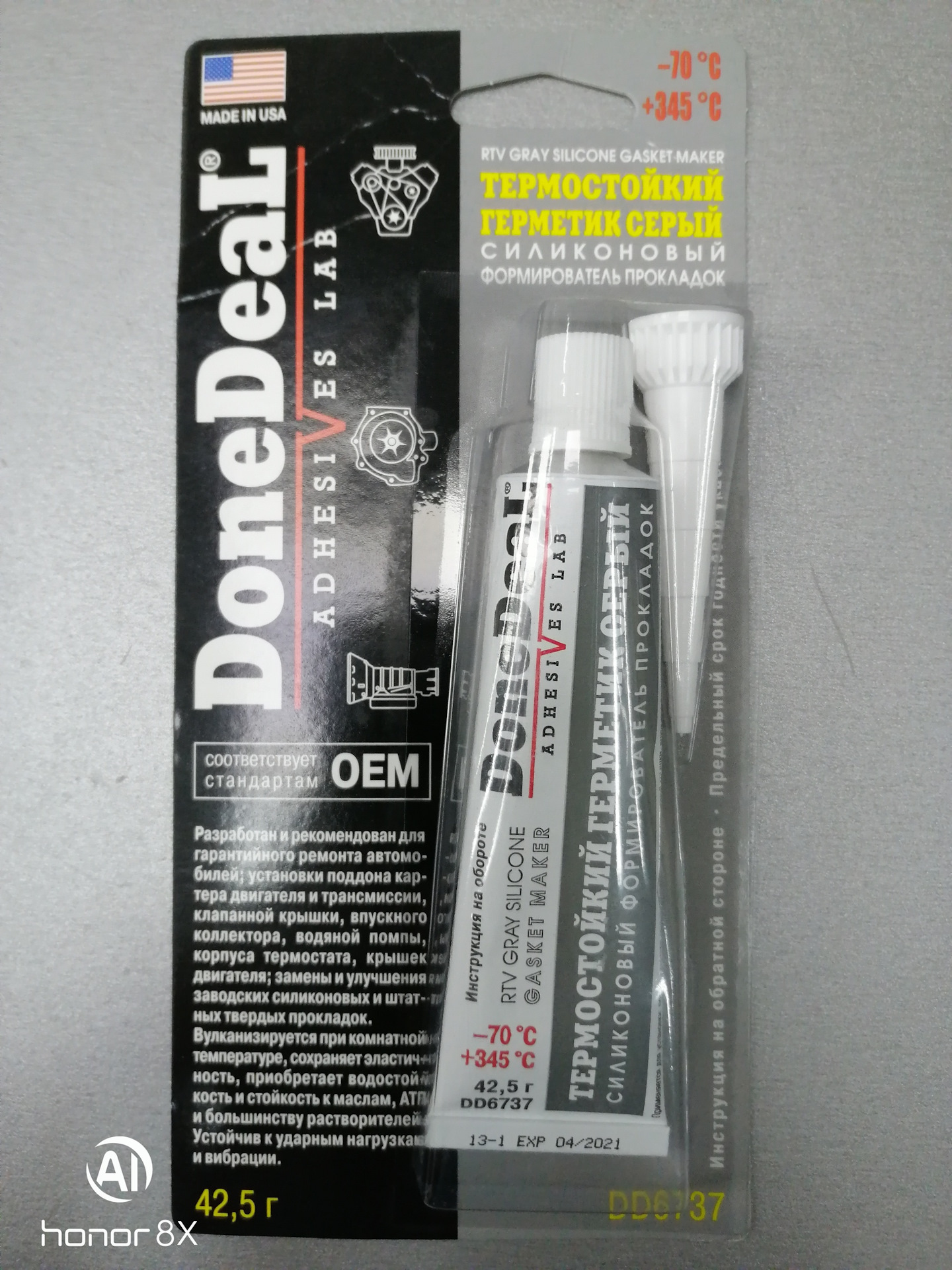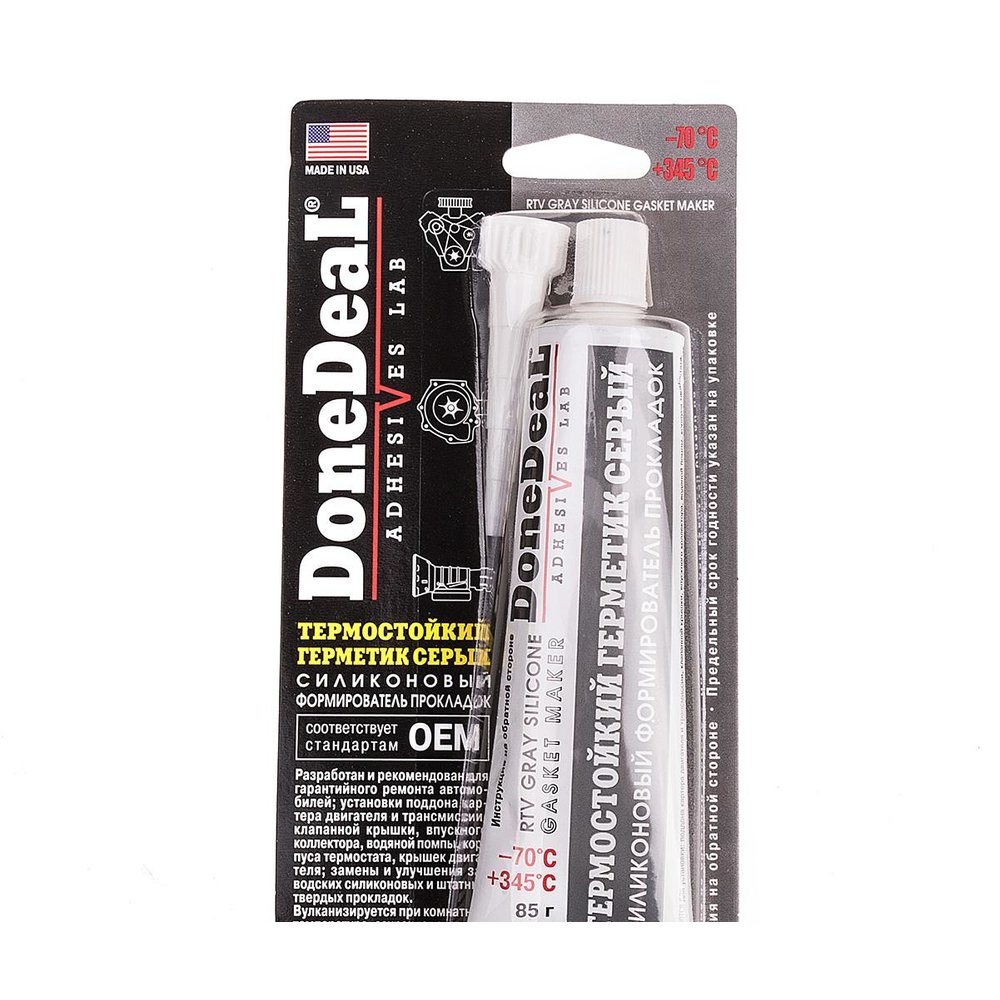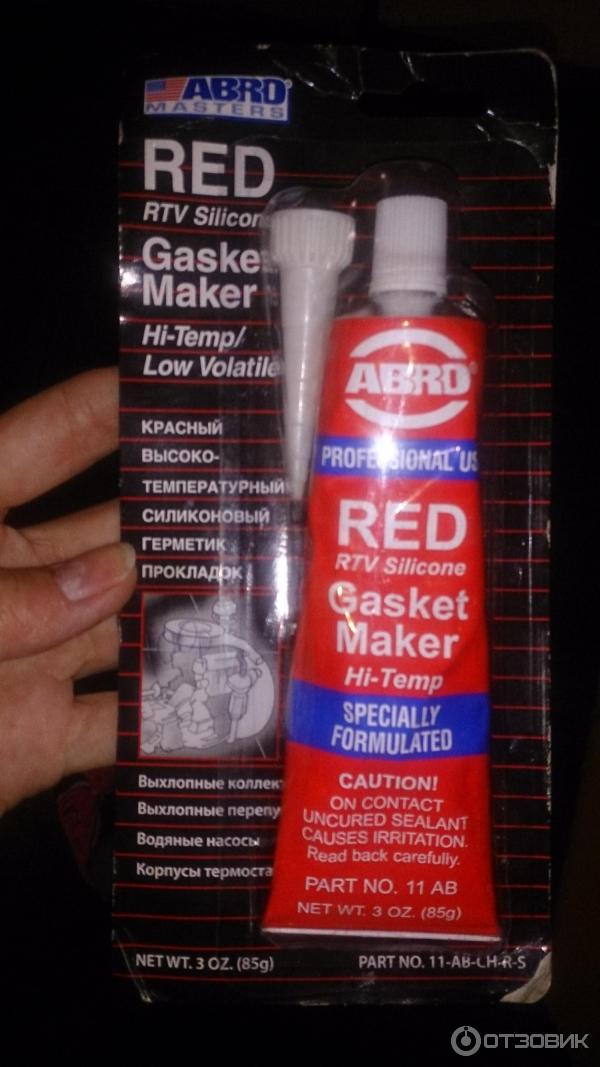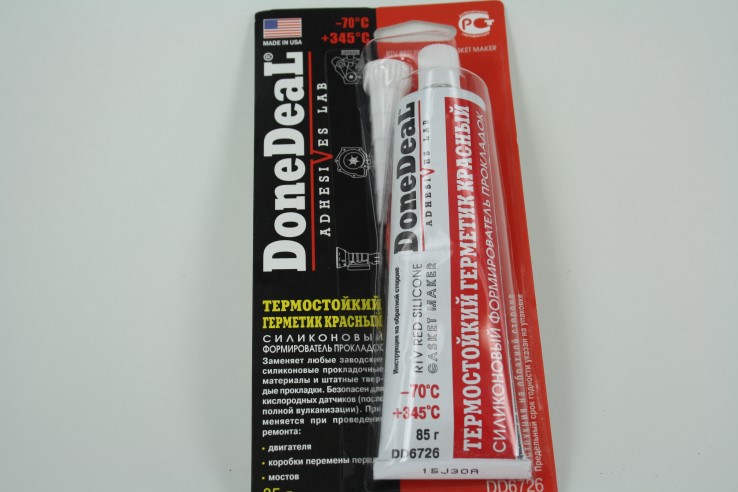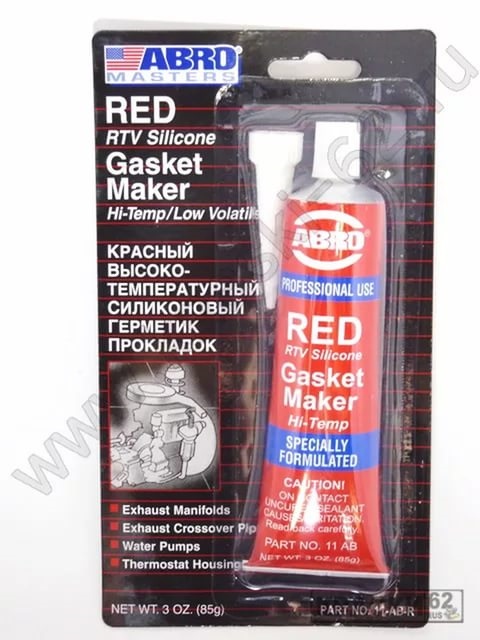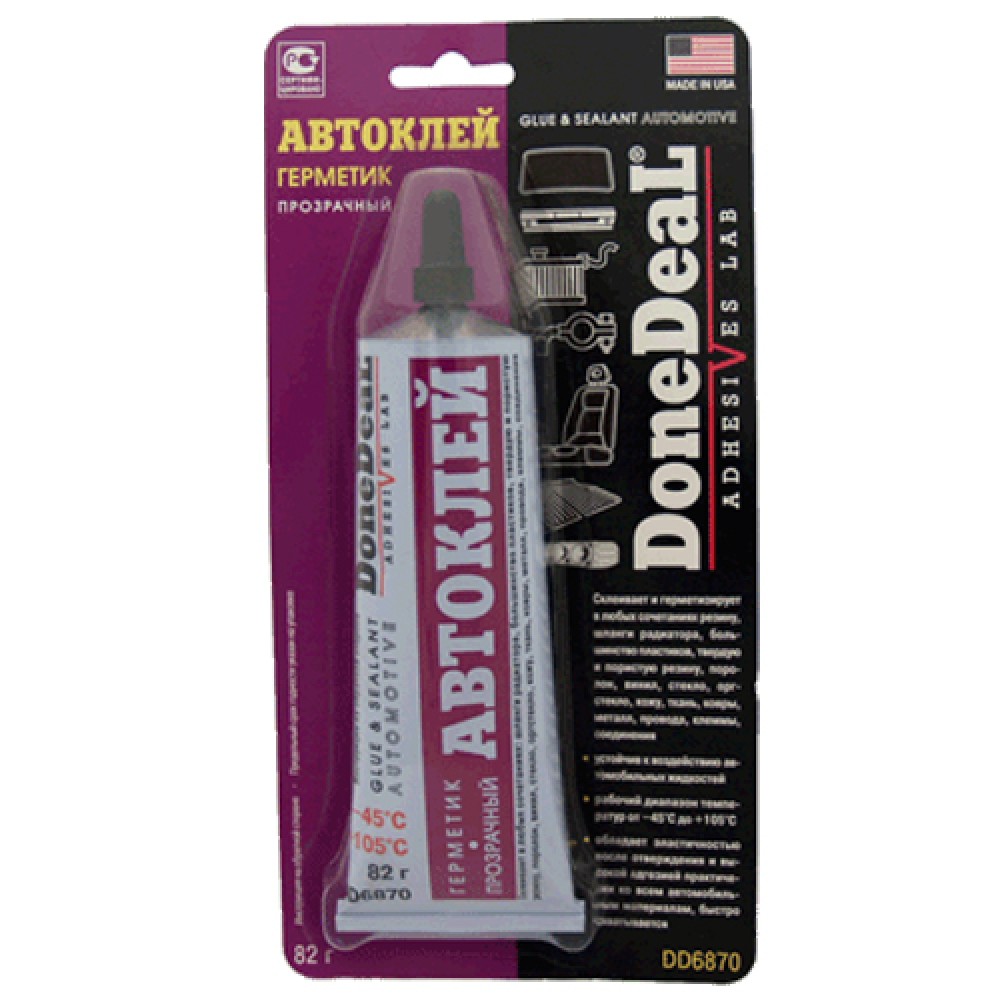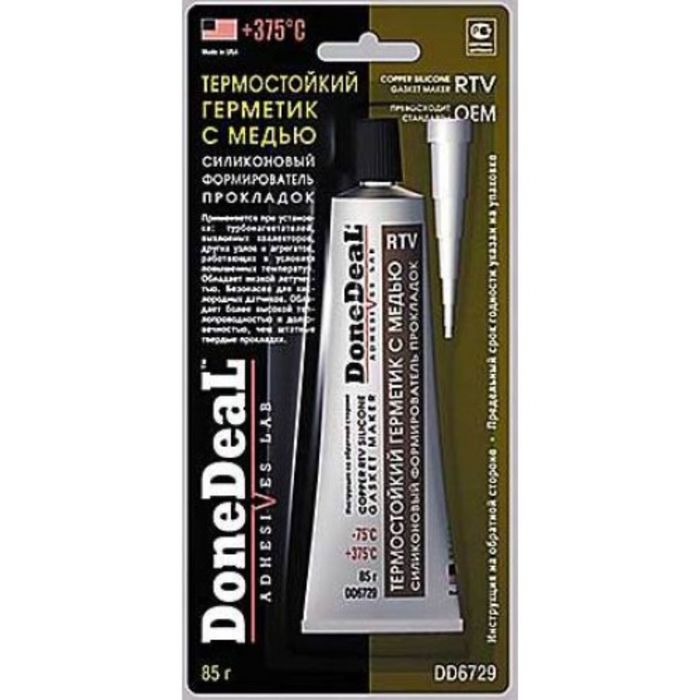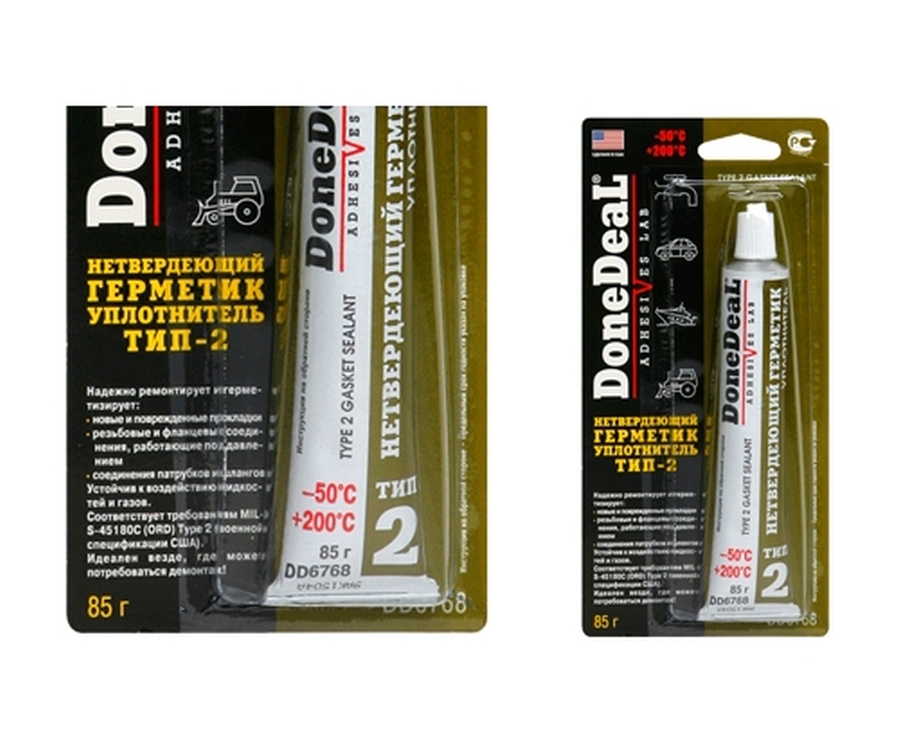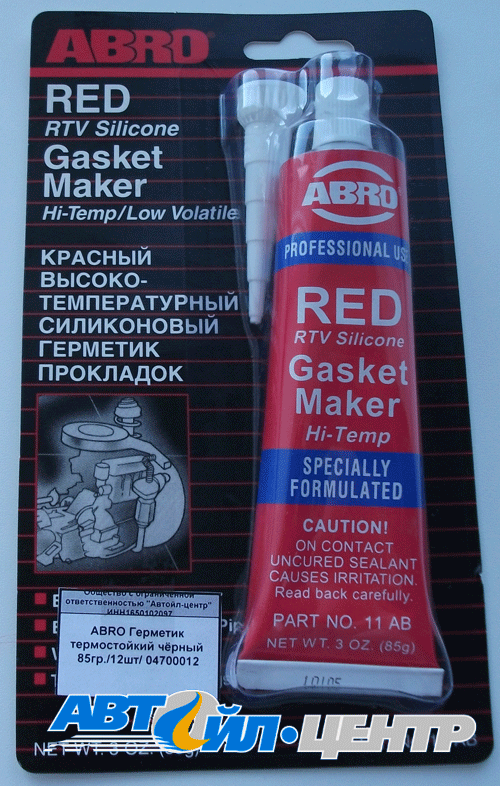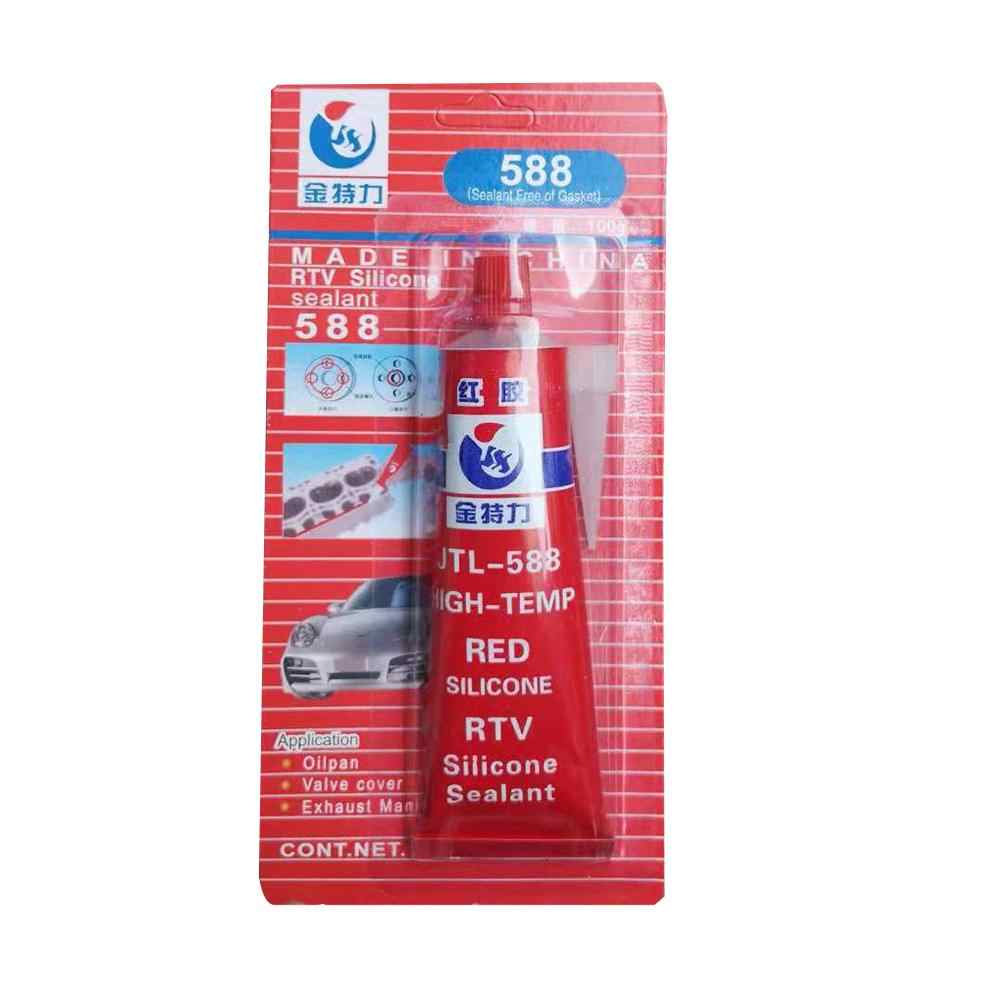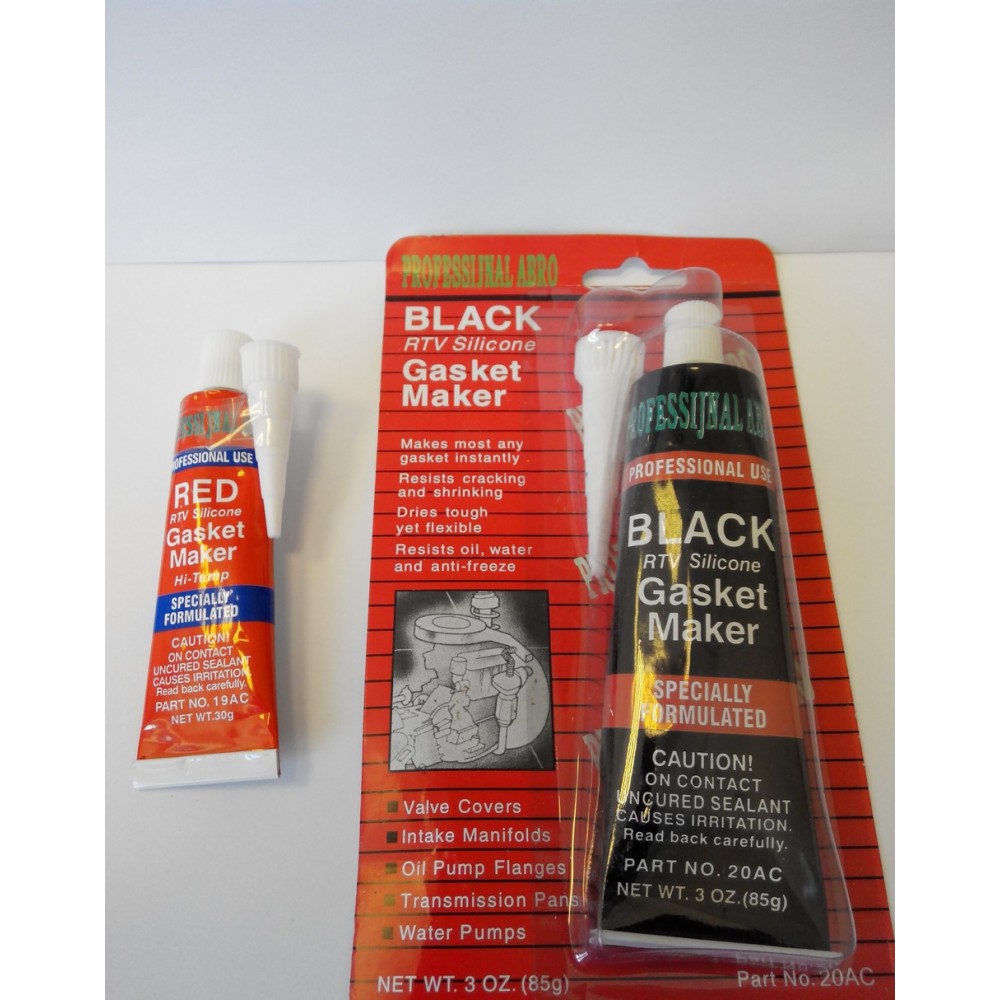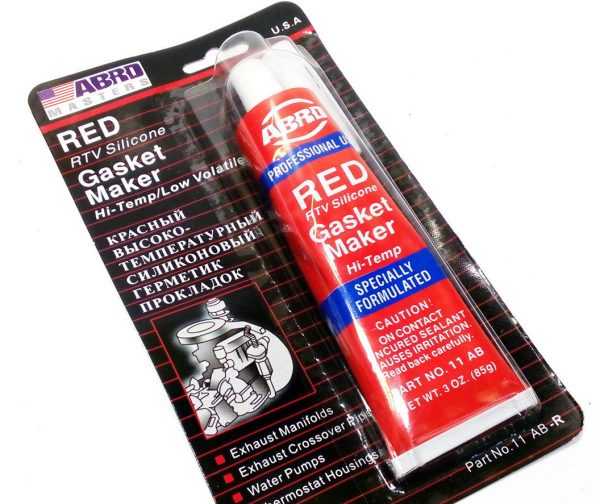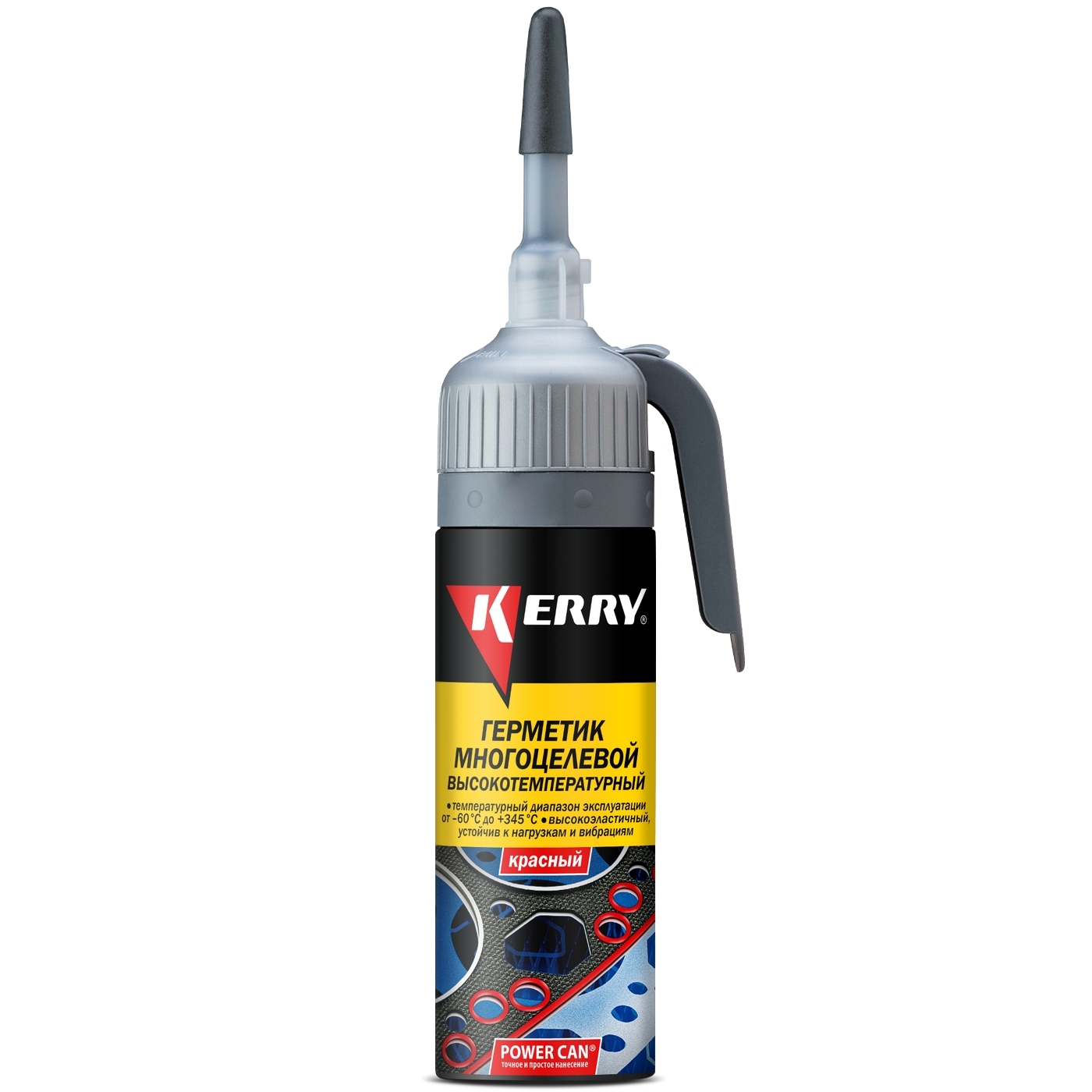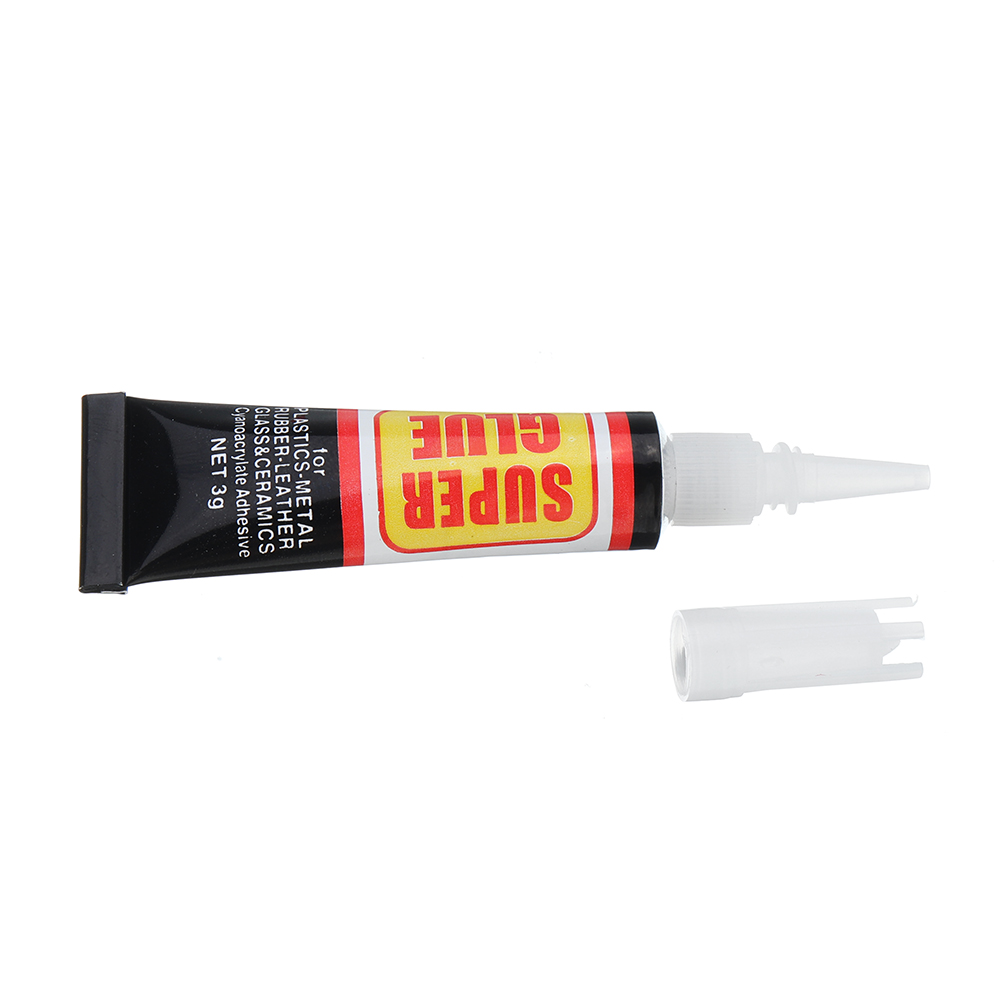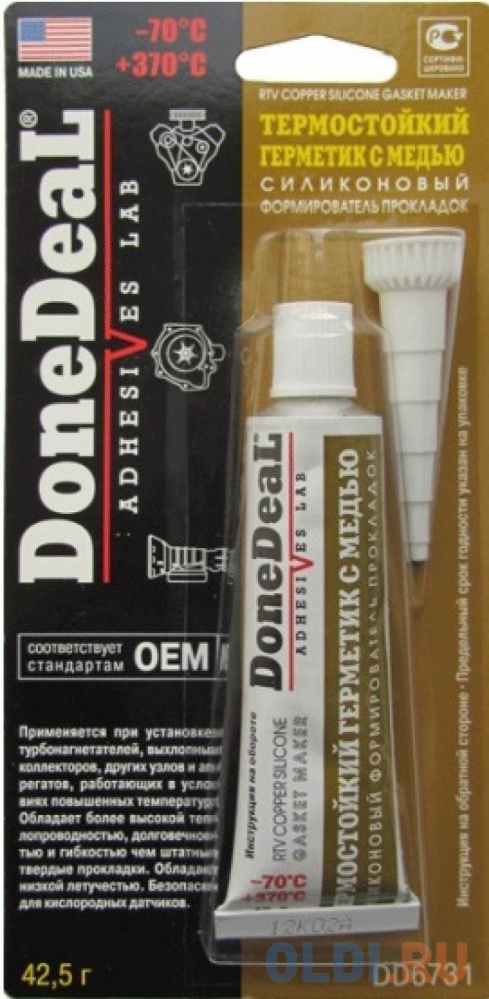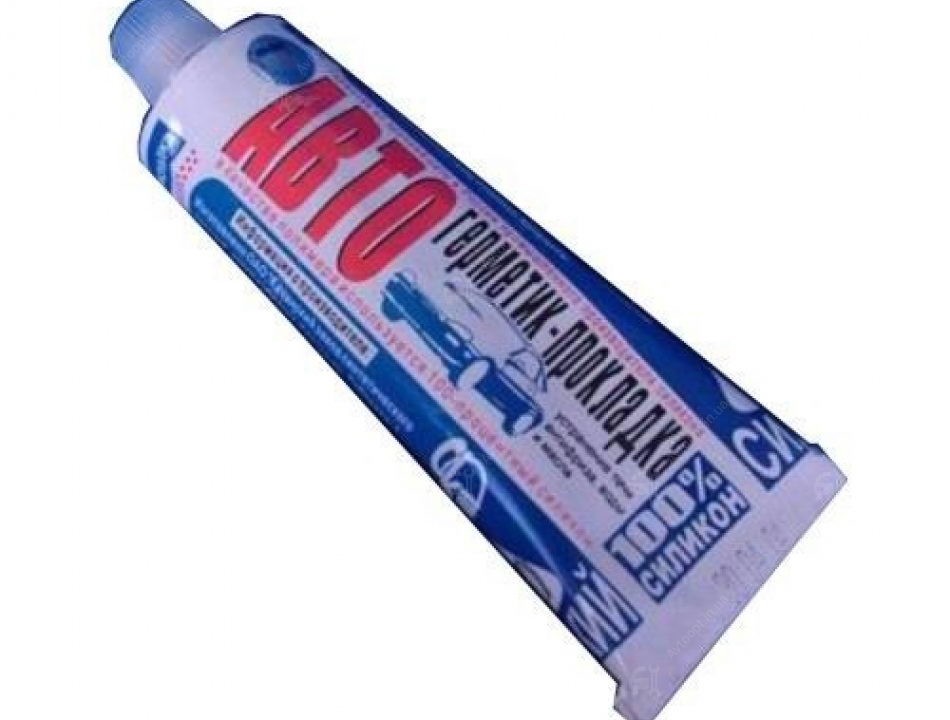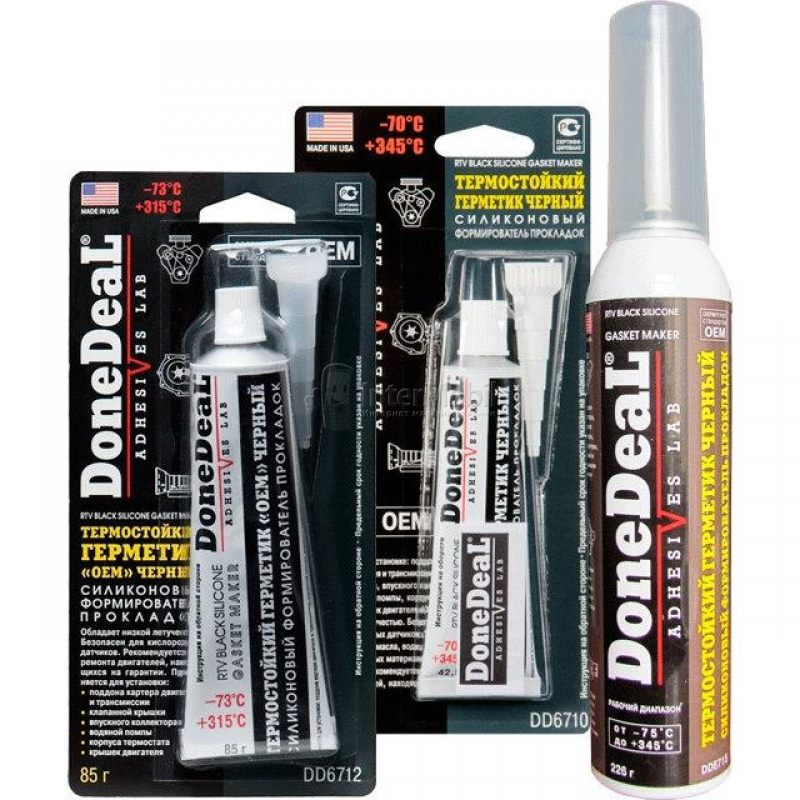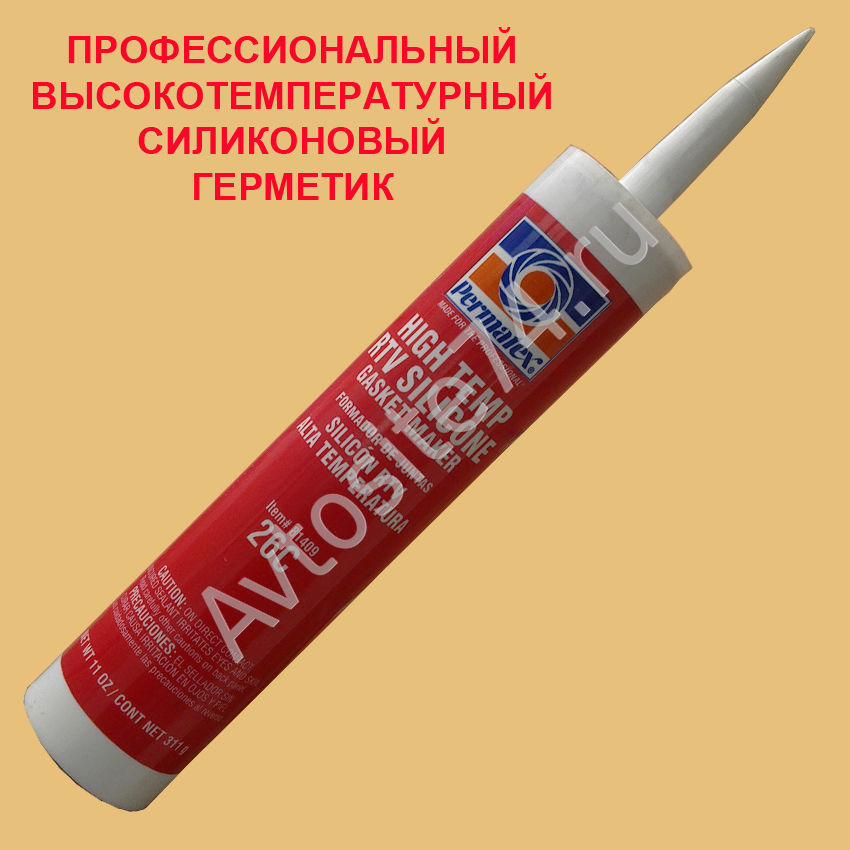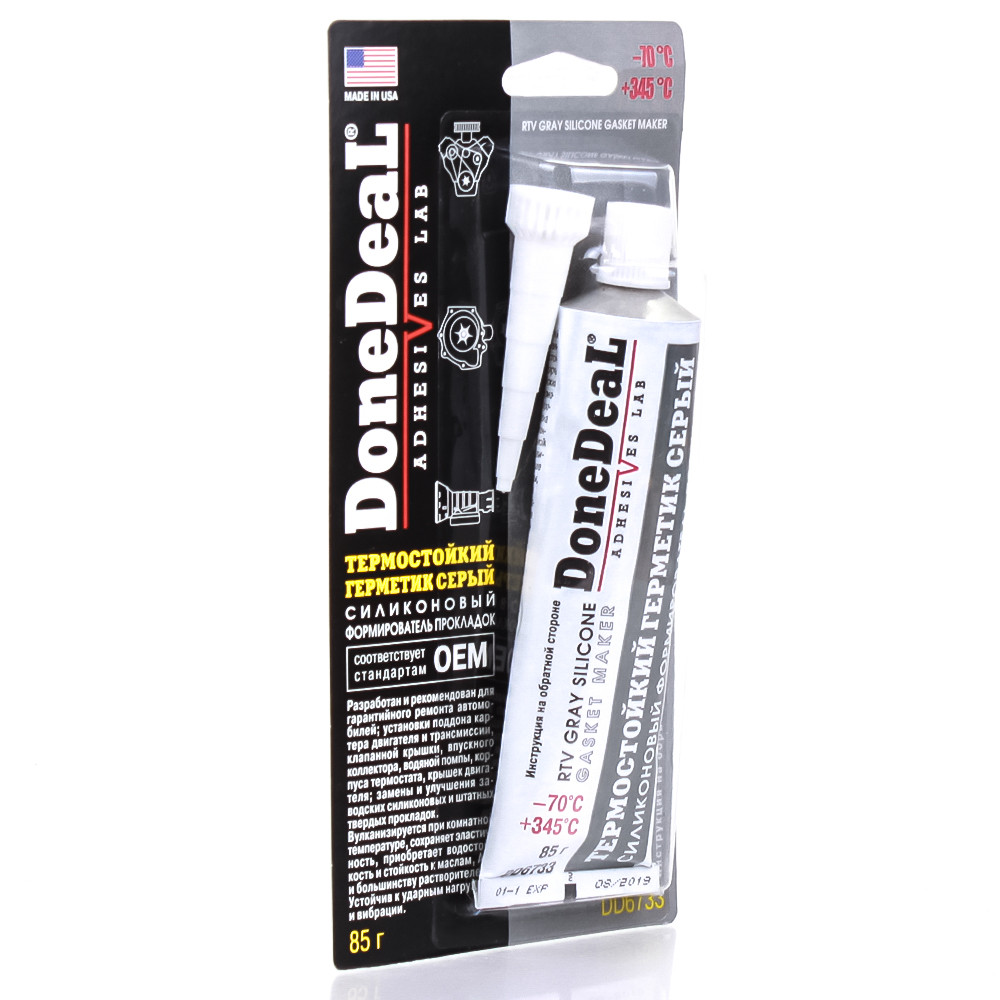Types of sealants and features of their composition
A number of types of sealant are sold, each differing in composition and properties:
- Silicone. It is created from organic silicon, which makes it possible to use it to connect different surfaces. Eliminates defect, gap up to 6-7 mm. Curing occurs due to oxygen in the air and humidity. The volume of the tube is from 40 to 90 g.
- Anaerobic. Contains stabilizers, acrylic monomers, hardener, colorant, plasticizer, initiating structure. Drying will occur in the absence of air, contact with metal. So do not rush to assemble the parts, but prepare everything carefully. If the mixture remains outside the joint in the open air, it will not solidify. The gluing gap does not exceed half a millimeter. The setting period in an enclosed space is up to half an hour.
- Synthetic. The composition includes resins, so the scope of application is expanding. Used when repairing fiberglass bodies. Work is required in PPE.
- Polyurethane. Bonds different surfaces, high adhesion. Produced in colors. That allows you to choose a shade for repair in a prominent place.
Rating of the best sealants
To work with automotive optics, you need to purchase high-quality tools so as not to know problems with the functioning of lighting devices.
ABRO WS 904
Sealant ABRO WS 904 - one of the most popular on the request of users. It is realized in the form of adhesive tape in rolls of different sizes, made on the basis of vulcanized polyisobutylene - a derivative of artificial rubber.
This butyl headlight sealant is highly flexible and easy to use - you just need to cut a piece of tape to the desired size, stretch and stick to the surface. A few seconds are enough to connect the ends of the tape to each other - the polymerization process takes place quickly. At low ambient temperatures, it is recommended to additionally warm up the sealant with a building hair dryer.
The advantages of the ABRO WS 904 tape are as follows:
- low consumption - there is enough packaging to completely seal the set of headlights;
- ease of installation - the tape does not stick to your hands, is pliable, easily cut off, stretched to achieve the desired thickness without effort;
- high degree of adhesion to most materials;
- lack of toxic secretions and unpleasant odor;
- strength, long service life after hardening, reliability and complete tightness of the seams.
Dow Corning 7091
It is recommended to purchase this sealant when working with dissimilar materials that have unequal coefficients of thermal expansion. It is able to create high-quality joints at the junctions of glass to metal, glass to plastic, metal to plastic, therefore it is perfect for the installation and repair of automotive optics.
Dow Corning 7091 Silicone Sealant is a one-pack, ready-to-use product that combines high strength with flexibility. The sealant is suitable not only for working with car headlights, but also for installing LED lamps, various electronic devices and complex mechanisms. After polymerization, the formed seam will reliably seal the joint, while it does not collapse from temperature extremes and can be operated at -55 ... + 185 degrees. The sealant is easy to post-process if required and is a good dielectric.
DoneDeal DD6870
DoneDeal DD6870 composition refers to polyurethane sealants, includes urethane groups, refined petroleum products, various polymers, adhesion promoters and other additives.
It can be used for installation and sealing purposes:
- headlights;
- glasses;
- lanterns;
- lamps;
- hatches;
- instead of gaskets.
The sealant dries completely within 15–30 minutes after application, has a high strength of seams, good adhesion to most materials, does not crack under the influence of vibration or shock. The product is characterized by moisture resistance, works without loss of properties in the temperature range from -60 to +270 degrees.
3M PU 590
Sealant 3M PU 590 is produced in the USA, has a polyurethane base, is packed in convenient tubes of 300-600 g. It does not tolerate a strong rise in temperatures (it can withstand up to +100 degrees), therefore it is not used on heated vehicle parts. The product polymerizes quickly (in 25–30 minutes), does not react to the action of acids, alkalis, solvents, is resistant to moisture and UV radiation, reliably connects even dissimilar materials. Once cured, the sealed joint can be painted over with most car paints.
Emfimastic PB
This brand of adhesive sealant is produced in France, contains polyurethane groups and various additives. Efirmastika glues homogeneous and dissimilar materials as reliably as possible, ideal for the installation and repair of automotive optics. The composition is odorless, hardens in half an hour, does not shrink, does not crack over time. It is not harmful to humans, does not have an unpleasant odor, and can even be used indoors. A hand or air gun is required to apply this elastic sealant.
Criterias of choice
There are several criteria to consider when choosing headlight adhesives.
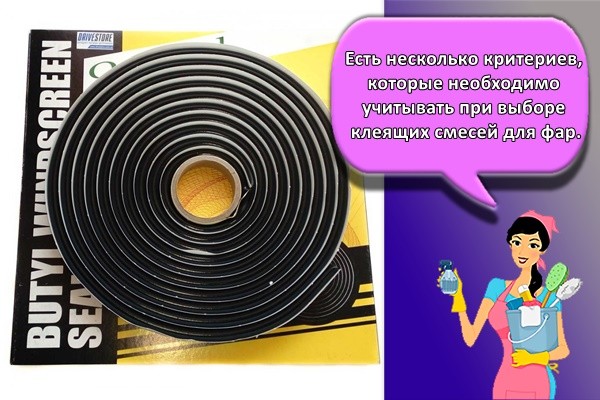
Reliability of bonding
Experts advise using high bond sealants. Such formulations will hold reliably, even if water gets on them. It is recommended to choose liquids that contain plasticizers. These components make them more reliable and durable.
Anti-vibration properties
To replace headlights in a car, compounds with anti-vibration properties are often used. Such mixtures are considered to be of fairly high quality, since they do not peel off even with strong vibrations. Therefore, anti-vibration compounds are most often used when gluing car headlights.
Resistance to temperature influences
Another criterion that is taken into account when choosing is resistance to low and high temperature indicators. When working with automotive glass and headlights, it is recommended to use a heat-resistant sealant. This is the latest product that is resistant to temperature changes. Heat-resistant compounds can withstand temperatures of 200-300 degrees above zero.
Packing volume
When choosing a sealant, you need to pay attention to the volume of packaging in which it is sold. Basically, such adhesives are sold in containers, the volume of which is 300-320 milliliters.
However, you can find the formulations in smaller packages. Some sealants are sold in cans of 150-200 milliliters. This amount of sealant is enough to repair or replace the glass on the headlights.
Ease of removal
When choosing an adhesive, you need to think about the ease of its further removal. Sometimes it is necessary to remove the remnants of the sealant that have crawled out of the headlights. It is recommended to choose funds that can be easily removed with improvised means. It is not worth choosing compounds that are removed only by mechanical means, as they can damage the surface of the car.
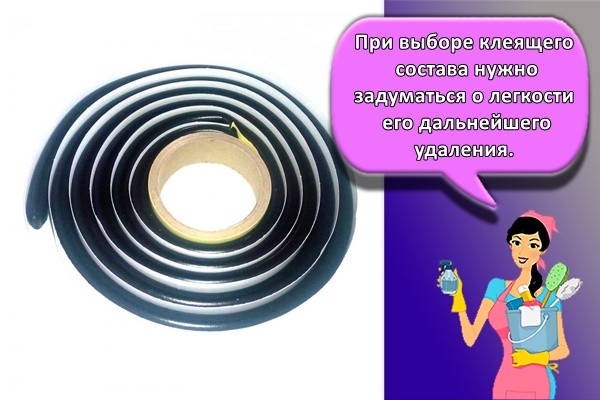
Transparency after application
The sealant can be either transparent or translucent. Experts recommend using completely transparent liquids, since after drying they do not leave marks on the surface and therefore they are practically invisible. However, if the product is applied under the headlamp, you can use translucent formulations.
Value for money
It is recommended to choose formulations with an optimal price-performance ratio. Therefore, you should not choose too expensive adhesives whose technical characteristics do not match the cost.
Sealant selection criteria
A variety of sealants are sold in car stores: for hatches, bodies, pipe connections. They differ in terms of heat resistance, elasticity, service life. The highest quality, but expensive, are professional products that are sold in large containers and are usually used in auto repair shops.
For home use, they buy sealants in tubes of a suitable volume (40-200 g). If you decide to give preference to the latter option, it is better to purchase the material in an aluminum tube: it fully retains its properties during the entire shelf life. Cheaper products are presented in plastic tubes, but when buying, you should definitely check the residual shelf life: it must be at least 6 months.
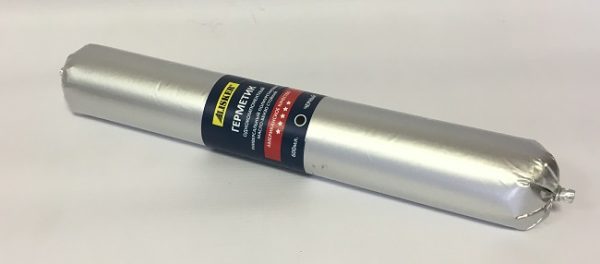
Some sealants have a convenient dispensing tip for easy application, even to hard-to-reach areas. The body sealant in the cartridge requires an additional purchase of a glue gun, without which it will not be possible to use the product.
Selection Tips
When choosing a heat-resistant adhesive for your own needs, pay attention to the following characteristics:
- elasticity;
- fire resistance;
- environmental friendliness;
- composition;
- tolerance to temperature differences;
- adhesion;
- heat transfer;
- shelf life.
Elasticity
High elasticity allows you to smooth out changes in the volume of material and glue, after applying a high-temperature effect on them. If there is no elasticity, the structure will quickly begin to deteriorate. The formation of cracks, as well as partial destruction of the structure, is possible.
Fire resistance
Different manufacturers have different fire resistance, and this must be taken into account when choosing. Some mixtures can withstand temperatures up to 50 o, while others are able to withstand short-term exposure to 1000 o and higher. Therefore, before buying, be sure to determine the temperature range, and then choose the composition that is suitable for this.
Special composition
The composition also has a significant impact on the characteristics of the product, because each manufacturer uses its own set of components. The degree of interaction with other materials, service life and other factors depend on it. Some components give the adhesive special properties that are not found in other products.
Resistant to sudden changes in temperature
Resistance to temperature extremes is important in situations where work is carried out outdoors. In this case, the glue will be affected not only by heat, but also by cold. Not all brands are equally good at coping with such temperature fluctuations, collapsing after several freeze-thaw cycles.
Environmental friendliness
Substances that contain harmful components, when heated, begin to release toxic compounds into the atmosphere. In this regard, they try to make heat-resistant mixtures from environmentally friendly materials.
Lifetime
An important indicator, since all brands of heat-resistant glue have a different service life and storage. Often these indicators depend on the influence of external factors and compliance with the operating conditions specified by the manufacturer. If they are violated, heat-resistant glue quickly becomes unusable, which affects the general condition of the structure.
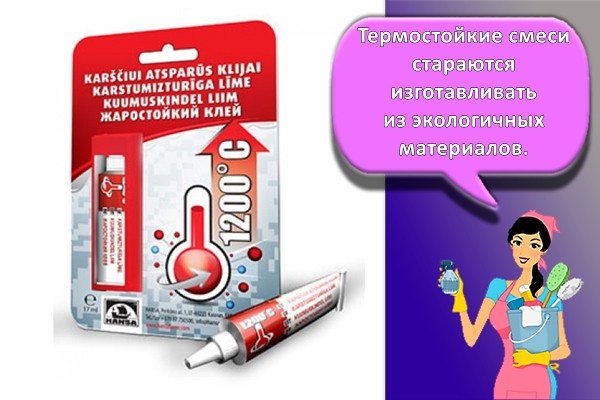
Heat dissipation
The removal of excess heat allows you to avoid:
- deformation of the structure;
- overheating.
High heat transfer rates of the glue guarantee the safety of the structure for a long period of operation.
High degree of adhesion
It is necessary when gluing complex surfaces such as:
- fireclay tiles;
- clinker;
- majolica;
- porcelain stoneware.
Heat-resistant adhesive with a high degree of adhesion securely fixes the tile in one place, preventing it from moving.
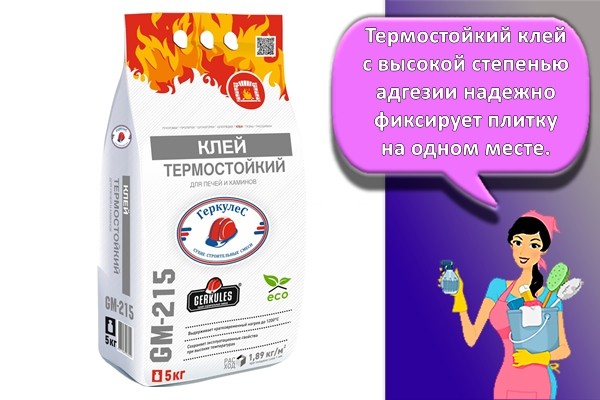
How to choose the right sealant?
First, you need to decide on the type of work that you are going to perform. If you have to work indoors, then a sealant is suitable for you to perform indoor work, if outdoors - for outdoor ones. The manufacturer always indicates this information on the label.
Secondly, assess the condition of those surfaces with which you have to work and determine their composition (what they are made of). Some formulations have additional properties that allow you to work on wet surfaces, worn or damaged by rust.
Next, look on the label or ask the seller for information about what type of work this or that composition is suitable for (roofing, window work or sealant is universal). Information should be also about its composition (silicone, acrylic), about the change in joints under the influence of heat (take into account the mobility and elasticity of the composition)
Pay attention also to the properties of the sealant. If in the future, at the end of the work, you need to paint it, then this aspect must also be foreseen in advance, since there are species that are not suitable for painting
For example, one component silicone sealant should not be overpainted.
You have probably already seen that the selection of the right sealant is multi-stage. Everything needs to be foreseen. Let's look at one example in practice, and it will immediately become clear to you how to take all aspects into account when choosing the right sealant.
Let's say in a room it is necessary to cover the seams with sealant between the plates during the assembly of the laminate. To do this, we need a tool for internal work that has the property of fast drying, water resistance, it must be thinly applied to the surface and have an average degree of adhesion (otherwise it will be impossible to repair the floor if necessary). The work is carried out indoors, so the sealant should not emit a strong odor. In this case, a sealant containing solvents will not work either, since you can spoil the laminate and corrode the substrate under it to the very base. When performing these works, we must choose a highly elastic sealant according to its composition, this will help to avoid cracks and voids between the panels and protect against moisture.
In this case, we recommend such sealants as: Click Guard or Clic Protect waterproof floor sealant, liquid cork sealant from the same Bostik, or RALY-ON vinyl latex sealant.
How to wipe off the sealant
For water-insoluble sealants, mechanical action is considered the easiest way to remove. This method can be used at home without attracting additional funds.
Using a knife, spatula or other similar tool, the old layer is simply cut off
This should be done very carefully so as not to damage the surface.
There are chemicals on the market that can soften a thick layer of sealant. The product then removes the old adhesive from the seams.
Acrylic waterproofing and polyurethane sealants can only be removed by cutting off the old layer. They are not affected by various chemicals.
The most famous chemical agents for removing old sealants today are Silicon-Entferner, Soudal Sealant Remove. They allow you to remove silicone from ceramics, enamel and plastic.
When choosing an adhesive sealant for specific needs, you should familiarize yourself with all the properties of this type. There are simply no universal seam and surface treatments. Having highlighted the necessary qualities that a sealant should have, you can choose its type correctly. Following the manufacturer's instructions, you can use each type of product presented as efficiently as possible.
What is the threat of a bad choice?
The wrong or wrong choice of sealant will lead to unpredictable results. This is a loss of transparency, unsatisfactory resistance of the seam to vibration, possible destruction due to moisture or an aggressive environment.
Reduced transparency of glass
The master, choosing the glue for sealing the crack, was a little mistaken (or the customer decided to save money) by using balsam instead of a transparent polyurethane compound. The result will not be long in coming: drips, visible sagging and color differences between the main structure and the seam. And also wasted money, lack of effect expected from glass repair.
Unaesthetic stains
One of the likely manifestations of a poor choice of glue. Stains can appear immediately after the start of polymerization, or a little later, during the operation of the glass. It is impossible to eliminate them, and this is the main problem of the sealant.
Increase in crack size
In the practice of craftsmen, it also happens that broken glass continues to collapse for a number of reasons: it expands (the crack lengthens), new chips appear. The fact is that in a car the windows are subjected to the same dynamic loads as the rest of the frame elements. If you do not restore the integrity of the glass, do not fix it securely in the opening, then irreversible processes will continue until it bursts completely or falls out.

What else to look for when choosing a product
Buying a sealant
for headlights, in addition to its composition, as described above, it is necessary
take into account other criteria:
- Vibration resistant. When driving, the headlights shake and the sealant should not
burst on the first bump. - High temperature tolerance: if you have halogen optics,
select the appropriate sealant. - The volume of one package - it should be enough for at least one repair
headlights. - Removal of surplus. Particles of funds should be easily removed from any
surface - metal or glass. - Transparency. This point is important when repairing cracks in glass. If
the product prevents the emission of light, the efficiency of the headlamp will be low, therefore
a colorless composition is needed. - Brand. Expensive doesn't mean good. However, cheap funds are not
will provide reliable sealing, and the procedure will have to be repeated again and
again, which is fraught with unnecessary financial spending.
Instructions for use for gluing headlights
In order for the sealant to reliably connect
surfaces to be bonded, follow the manufacturer's recommendations. but
there are some general rules to maintain transparency and
ability to color rendering of headlights.
Gluing must be done in the following algorithm:
- before starting work, wipe the parts to be glued, cleaning them from
dirt and degrease (use white spirit, solvent, nefras, in
as a last resort, acetone, which will not work if the car is plexiglass), avoiding hitting
means for body paint and plastic; - if the room is cold (temperature below that specified in the instructions),
warm up the surface with a hairdryer; - remove the old sealant;
- if the product is liquid, use a dispenser or disposable medical
syringe.
After installing glass or assembling shards
remove excess funds. If during the operation of the car you notice that
delamination occurred (this is what polyurethane compounds "sin" about), disassemble the block with
using a solvent based on the same PU.
Polyurethane sealants
Compared to other sealants, the presented glue has very good elasticity and resistance to deformation.
This adhesive sealant is often used by motorists, since the substance is not afraid of weather conditions or exposure to chemicals.
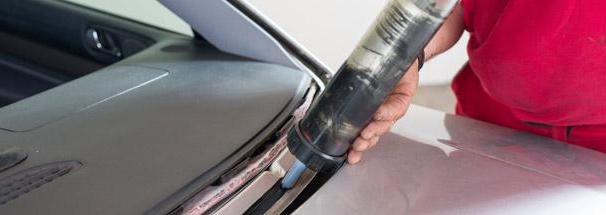
It is often used on difficult surfaces such as aluminum, reinforced concrete, ceramics, stone, etc.
The only drawback of polyurethane sealant is its toxicity. This substance is caustic and quite dangerous if the rules for its use are not followed. Most often, because of these characteristics, polyurethane sealant is not used for interior work. The main field for this product is working outside the home.
It is an ideal sealant for facades and roofs. Due to its ability to withstand stretching, bending, shearing, this substance is widely known as an automotive adhesive sealant. Thanks to the choice of its color, it can be used for various joints without further painting.
Automotive sealant: how to achieve a good result?
Choosing the right sealant is an important step, but is nevertheless just the beginning.
It is also important to apply the product correctly so that the result is positive. Below are some useful tips for using auto-sealant:
- Clean the surface thoroughly before applying the product.
- For better adhesion, you can pre-strip the application area if possible.
- Be sure to degrease the surface and dry thoroughly.
- If possible, use a special air gun - it provides the most uniform application.
- Prepare a rubber trowel so you can quickly remove excess and trim the edges.
- Thickened silicone or polyurethane sealant can be thinned with anti-silicone. Also use a substance to prevent the sealant from stretching or sticking.
- No additional action is required before painting the sealed surface: just wait until it dries.
If it is necessary to remove the sealant, it must first be warmed up with a technical thermal blower or an ordinary hair dryer. It is worth removing the substance in small areas until it has cooled down. Be careful when working with plastic parts - they must not be overheated! If surface appearance is not critical, it is acceptable to cut the sealant with a sharp knife.
It should be understood that we can only give general recommendations for the use of auto chemistry. However, sealant and sealant differ, and the properties of even similar products differ from manufacturer to manufacturer. Before starting work, you should carefully study the information on the package.
With an understanding of how to choose an automotive sealant, you can safely start looking for the right solution.
Select Automotive Sealant
Criterias of choice
When choosing a sealant, it is important to be guided not only by the manufacturer's promises and reviews from other motorists, but also by what parts the composition is intended to repair, what temperatures it can withstand, whether the part being repaired is subject to constant vibration or not. Based on this, the car owner chooses a suitable composition, otherwise the exhaust system will need new repairs after a short time.
Temperature working range
The most important indicator, it depends on how long the sealant will perform its functions. The higher the operating temperature range, the better.
In order not to be mistaken with the choice of sealant, it is important to carefully read the information on the packaging and pay attention to how long the composition will remain stable at the specified temperatures.
State of aggregation
All high-temperature sealants are divided into silicone and ceramic, the product's resistance to constant vibrations and vibration depends on the composition.
Silicone
Used in spacers between parts. After the composition has frozen, it remains a little mobile, so it is not afraid of constant fluctuations.
Ceramic
Used to correct cracks, holes and rusted parts. After complete drying, the composition becomes hard, which is why it does not withstand constant fluctuations. It is best to use this sealant when repairing stationary parts of the exhaust system.Motorists are more likely to use silicone-based sealants because they do not crack on both moving and stationary parts of the exhaust system.
Type of
All high temperature sealants are divided into several types depending on their characteristics.
For repairing the exhaust system of a car
The basis is fiberglass, to which manufacturers add additional substances. A distinctive feature of sealants is the hardening time, it rarely exceeds 10 minutes. Compositions tolerate high temperatures well, but crack under constant vibration and shock, and are designed to eliminate damage to the exhaust pipe
Assembly paste
The composition quickly hardens and does not lose its properties even due to high temperatures. Used when installing new or refurbished items.
Muffler sealant
It is often used as a prophylaxis; it takes some time to completely solidify. It is a versatile product that can be used to repair any part of the exhaust system.
Muffler cement
Such sealants form a hard layer on parts and are not afraid of high temperatures. The most durable compound used to repair stationary parts of the exhaust system.
Taking into account the above features, the masters select the desired type of composition based on the existing damage and the operating conditions of a particular part.
Silicone glue - description
What is silicone? It is a high-strength organosilicon polymer, a chemical compound of a high molecular weight type. In appearance, liquid silicone looks like resin; synthetic rubber is used to create it. It was invented in the middle of the 20th century and is now widely used. The most popular products based on it are glue and sealant. In the production of adhesives, in addition to silicone, other substances are used, called targeted additives, fillers.
What can be glued with this tool, where is it used? Silicone compound is perfect for gluing:
- ceramics;
- metal;
- plastics;
- rubber;
- glass products;
- paper;
- aluminum;
- tile.
The scope of use of silicone is so wide that it is impossible to list all directions. In industry, it is used to make dishes, kitchen utensils, for example, baking dish sets, pastry bags. Silicone can be used to seal bathtubs, window glazing, it is indispensable in cosmetology and medicine.
Actually silicone adhesives are used for the repair of equipment, electronics, radio-technical products, for crafts. But the most popular tool in everyday life, at a construction site, for repairing premises, especially where increased moisture resistance of materials is needed.
Technology for working with glue for rubber
Subtleties of the process
Works using rubber glue must not be carried out in rooms where the temperature is below +5 degrees Celsius.
Surface preparation
To increase the efficiency of joining parts, before applying the adhesive, their surfaces are prepared. Extraneous inclusions are removed from it, for example, dust, dirt. Traces of moisture, oils and grease. Immediately before applying the glue, it is advisable to treat the surface with an abrasive paper. This will increase the adhesion of the parts to each other. A soft, lint-free cloth is sufficient to remove foreign objects, while degreasing liquids such as acetone can be used to remove grease and oil stains.
Adhesive application
To apply the composition, you can use a brush, if the mixture is thick, then you can use a spatula, its width and shape must be selected in place. The layer is applied at least 2 millimeters thick. The thickness of the applied layer is determined by which parts are to be joined. So, when repairing shoes or a rubber boat, it is permissible to apply an adhesive layer with a thickness of 1 mm. In this case, a layer of gauze is placed on the glue and press it with a spatula.Gauze acts as a reinforcing element. After a while, usually 15 - 20 minutes, apply a layer of glue again. To improve the adhesive bond, it is recommended to place the parts under the load and leave for several hours. Excess glue must be removed. The maximum bonding effect will be achieved after 24 to 48 hours.
Composition and application of glue for rubber
Rubber glue is a solvent in which rubber is dissolved. Such a composition presents great opportunities for creating adhesive joints. In addition, rubber-based glue guarantees that the seam between the parts will be elastic and therefore one of its areas of application is the processing of elastic materials.
Chlorine-containing compounds are most often used as rubber solvents; in addition, the use of aromatic hydrocarbons is permissible. But these substances are toxic, and their use is not always safe and therefore they are used in minimal quantities. Mostly they use ethyl acetate (ethyl ester of acetic acid) and nefras (refined products - gasoline, diesel fuel, etc.)
To reduce the risk of fire and reduce toxicity, adhesives and latex containing water. But the glue made using this technology is made with less adhesion.
Various resins and low molecular weight polystyrene can be added to the adhesives. These additives increase the strength of the glue line. It should be noted that the addition of more resins and polystyrene can lead to a loss of elasticity.
Various substances are used for vulcanization, their choice is due to the parameters of the selected rubber. Sulfur and metal oxides are most often used; amines can be used as agents during cold vulcanization.
In the production of adhesives, mineral oils are used, which play the role of plasticizers. Ethanol stabilizes all processes. It is designed to prevent getting the gel. Carbon black acts as a filler.
The above substances are part of any glue for gluing rubber, but each manufacturer has its own recipe and I must say that most of the recipes are kept in strict confidence.
The strength of the seam obtained by gluing rubber parts, as a rule, is greater than the strength of the rubber itself. For gluing rubber, technologists select glue that is close in composition to the substances to be glued. The universal glue is made on the basis of polyurethane. It allows you to connect different types of rubber together. For gluing leather and fabrics, water-dispersion glue is often used.
Among consumers, such formulations as are especially popular:
- Moment glue;
- 88 and its derivatives;
- Adhesives No. 3125 and No. 3126
The use of rubber glue of these brands is permissible both in everyday life and in industry.
Advice
As you already know, the range of sealants with an adhesive effect is so extensive that sometimes it seems impossible to choose the one you need on your own. When buying, it is worth contacting consultants, because they will help you decide on the choice of a product depending on the surface to be processed. Do not be afraid to ask the seller for documentation about the presentation of the product brand. The shelf life is usually 18 months from the date of production. Storage should be tightly closed, while adhering to the temperature indicated on the bottle.
Before buying, you need to focus on the percentage of the components, which should be as follows:
- silicone - at least 25%;
- rubber mastic - from 3 to 5%;
- acrylic - 4-5%;
- polyurethane - 3-5%;
- the content of the cement mixture is not less than 0.4%;
- epoxy resin - 2%.
Attention should be paid to the timing of the manufacture of the adhesive sealant, its quality, and to avoid such products:
- with a damaged label;
- low cost, which raises suspicion;
- with a note that silicone is 100%, because absolutely all manufacturers use additives;
- with a light tube weight;
- with the lack of information on the cylinder and composition;
- the seller does not have copies of the quality certificate.
In the next video, you will find a detailed overview of the Soudal universal adhesive sealant.
Advantages and disadvantages of sealants
Automotive silicone sealants are produced in the form of a mass of a viscous substance, which is used to cover cracks, joints, etc. Neutral silicone will withstand an increase in temperatures. Acidic ones are rarely used in car repairs, as they expose metal to a corrosive coating. Also, such material cannot be painted from above.
Silicone mixtures are easy to apply and can be repaired by novice craftsmen. But thorough cleaning of the surface is required before application. The seam turns out to be flexible, withstands increased pressure, and retains its operational properties for a long time.
Anaerobic car sealant is used to repair power equipment. The advantage is that there is no time limit during the repair, since only tight pressing of the metal parts and the cessation of the oxygen supply contribute to the solidification of the mixture. The seam turns out to be flexible, the connection is of high quality and durable.
The disadvantages include a small permissible filling thickness of up to half a millimeter. If the area of compression is large, it is difficult to achieve tight compression to completely remove air.

